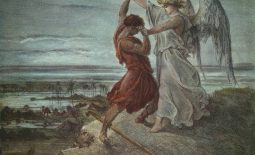The Crash
Part I: The Crash
This is the first sermon in a two-part sermon series. Please tune in next week for part two.
I hope you’re ready to get in a time machine with me today.
When I was a rabbinical student in 2011, I was asked to give a sermon at a British synagogue on Parashat Mishpatim, the Torah portion that follows on from this week’s portion, Yitro. Idealistically, I imagined ‘Matan Torah’, the giving of the Torah on Mount Sinai, as a United Nations-esque international plenary. This was the time of the Arab Spring, of ambitious climate accords, such as Copenhagen and Kyoto, and not too long after the Occupy Wallstreet protest movement. This felt like another fork in the road towards progress and justice. My sermon opened with this imagining:
“Suppose you would participate at a high profile global summit on ‘fighting racism, combating climate change and encouraging economic development’? Ah, and throw in ‘immigration issues’ and ‘sustainable living’ for good measure. And you were asked to present your solution to all these momentous problems in a grandiose plenary session attended by the world’s heads of state.
Progress of the global summit is being reported, blogged and tweeted around the world. CNN and the BBC have descended on site with film crews. Angry demonstrators assemble to picket the summit. The proposed change is not radical enough, the change is too radical. It is a cacophony of voices and opinions.
And you? You have to offer a vision and hold the line.
Could you do it?”
We will revisit the question, ‘could you do it?’, but for now, let’s dial back the time machine a little further. I’ve been paying attention to social movements for a long time. I remember taking part in many a protest march across Europe in the late 1990’s and early 2000’s. The last European-wide march I took part in, centering the demands of climate change, economic justice and combatting racism, was in Genoa, Italy, in the summer of 2001. My university friends and I had bussed in from the Netherlands, and I remember the searing sunshine upon the gritty, Italian port city. We thronged through old, narrow streets, banners and placards held high, loud chants bouncing off the dusty-colored buildings. It felt exhilarating. The Soviet Union had collapsed a decade earlier, the Internet was young and surely, liberal democracy and human rights would prevail. It was the political thinker, Francis Fukuyama, who argued that we had reached ‘the end of history’, and for a moment, we had.
A month later, after classes had resumed, I was wandering the halls of the University of Amsterdam for an afternoon class. I saw the plane hit the second tower in real time.
Crash.
Nothing would be the same.
I am not sharing this backstory to suggest the moral primacy of a particular ideology or form of activism. Rather, this story provides us with snapshots in time, in particular of the early 21st century, and the crashes that follow. Each of us have our own crashes etched in our memories: the shooting of President Kennedy, 9/11, the murder of George Floyd or the WHO’s declaration of a coronavirus pandemic emergency. Our most recent ‘crash’ (at least in the Jewish world) is of course 10/7. These moments engender a Before and an After.
Our Biblical and Rabbinic tradition is also marked by these crashes, where mythology and history clash and combine. Abraham leaving Ur, Joseph assuming power in Egypt, Moses confronting Pharaoh, and of course, the Revelation at Mount Sinai. Pushing on, is the conquest of Canaan, the building of the first Temple, and a seemingly unending series of disruptions: expulsion and exile, return and rebuilding, loss and flourishing, creativity and resilience.
As we find ourselves unmoored by these crashes, we ask ourselves what our stabilizers are. In this week’s Parashah, the Aseret Dibbrot, the Ten Utterances (colloquially known as the Ten Commandments) are such an anchor. It’s not that the Ten Utterances are necessarily more important or more binding upon us that other mitzvot, but they ground us morally and theologically. When we hear the words (Ex. 20:1), even today, we find ourselves standing or sitting up a little straighter. ‘Anochi Adonai Eloheicha asher hotzeiticha m’eretz Mitzrayim, m’beit avadim’ – ‘I am the Eternal your God, Who took you out of the Land of Egypt, the House of Bondage.’
There is reams of commentary on this verse, of course. What did God want to prioritize in the covenantal relationship? What does it mean to place this verse at the center of our identity or moral commitments? I will have to leave those specific questions unaddressed for now, and focus rather on the anchor this verse represents. If this is the opening statement of our plenary, then what is its significance? If we map this statement upon the historical fractures of our age, then what patterns emerge?
When we survey the disruptions of our own time, two complementary insights emerge: we hold onto eternal values and we adjust them to the call of our own age. While my 2011 sermon reads a little naively now, I also knows that our Jewish tradition is robust enough to help us through our current crash.
I’m using the word ‘crash’ intentionally, and I am borrowing it from Rabbi Benay Lappe, the Rosh Yeshiva (‘head of the learning center’) of Svara, a ‘traditionally radical yeshiva’. Rabbi Lappe talks often about ‘crash theory’. Crash Theory is her framework (drawing on Queer theory) for how Judaism handles historical disruptions and learns to tell a new master story. The main example is the ‘rabbinic revolution’, a phoenix-like reimagining of Jewish life and textual interpretation after the destruction of the Second Temple in 70 CE. Rabbi Lappe anticipates another ‘crash’ in our time, leading to an emergence of a third and new Jewish era.
She writes:
“In the language of the crash theory, we’re at the tail end of the crumble and the beginning of the real crash. You know how the story goes–full-on crashes don’t just happen out of the blue. They are preceded by a long period of “crumble” during which time most folks are blissfully happy with how the master story is working for them, while that very same master story is crashing for the rest of us on the margins, one at a time.”
If we relate this to the Parashah, we can see that the Exodus from Egypt was such a crash. Revelation at Sinai was a new layer in the master story; a liberatory story.
For our time, 10/7, was such a crash.
She continues:
“…the folks on the margins, for whatever reason–the folks for whom the master story crashes early, are prophets. You are the ones who move through the world embodying the truths which manifest the possibility of a more liberatory future.
The Rabbis envisioned and created their more-liberatory Jewish future–what we now call “Judaism”–while they were in the middle of a crumble. That’s where all liberatory prophetic futures are born. In the crumble.”
Among the discombobulation of our crash, Rabbi Lappe’s expansive, historical vision offers a strange but potent comfort. We have been here before. Crashes are hard; excruciating even. We should not minimize their cost or trauma. The Ten Plagues laid waste to Egypt; and even the Israelites had much trauma to process upon their escape. At the same time, when we feel powerless in the face of crashes and crumbles, Rabbi Lappe reminds us that our power lies in the meaning-making and resilient creativity we bring to our moment. For Moses, this was the Voice of God, proclaiming a universal truth of collective liberation, out of the House of Bondage. The new master story of the Aseret Dibbrot, the Ten Utterances, gave us dignity, equality, rest on Shabbat, honor of our fellow human beings and care for the vulnerable.
And for us? It may be too early to tell what will rise out of the rubble of our crash. This is what we will explore in Part Two of this sermon, next week (so stay tuned!). We do not need to be passive bystanders on the margins of destiny; we can steer that process and imagine it, just as I tried to do so in 2011. It fills our lungs with oxygen among the many frailties we may feel. It reminds us of the power of moral imagination. It makes us feel less lonely on the long trek of history. It gives us our power, our place and our purpose.




